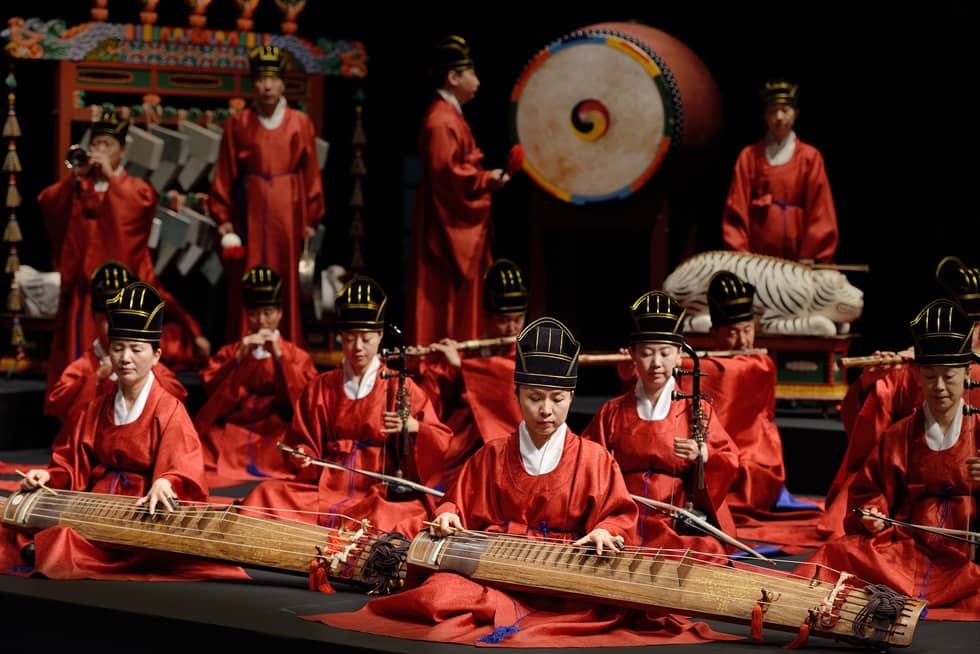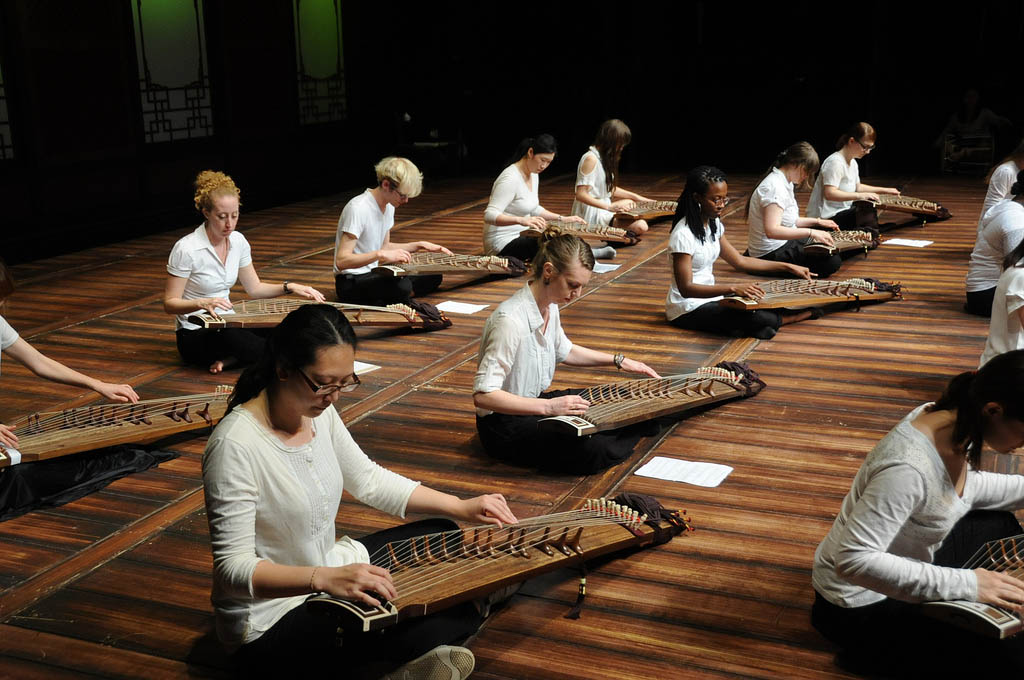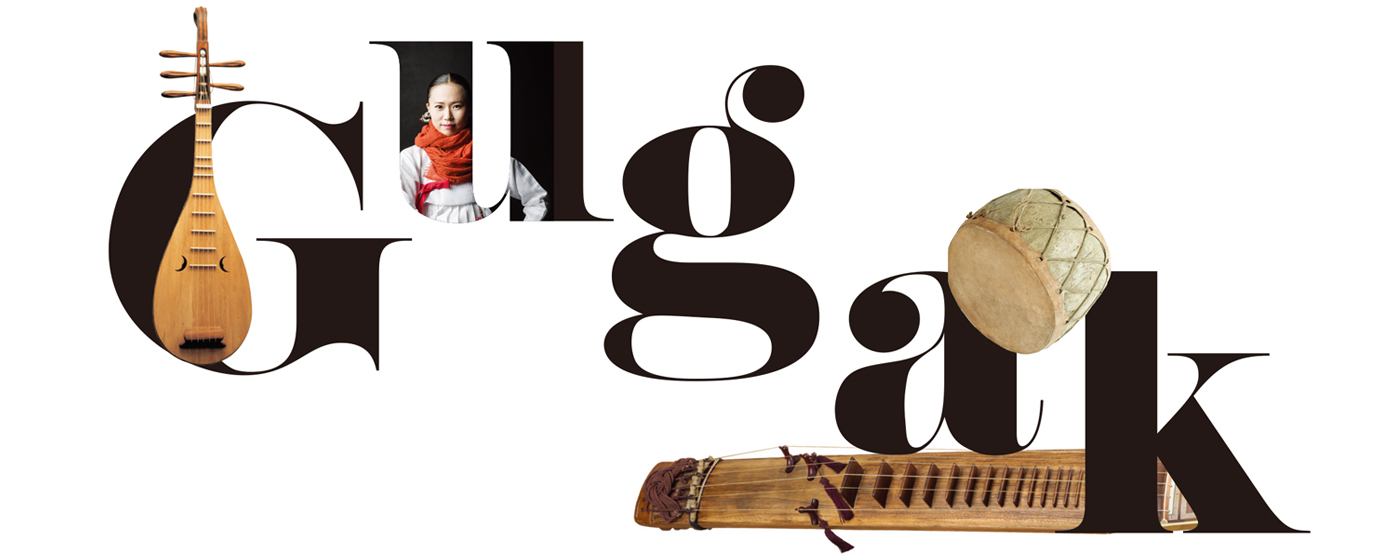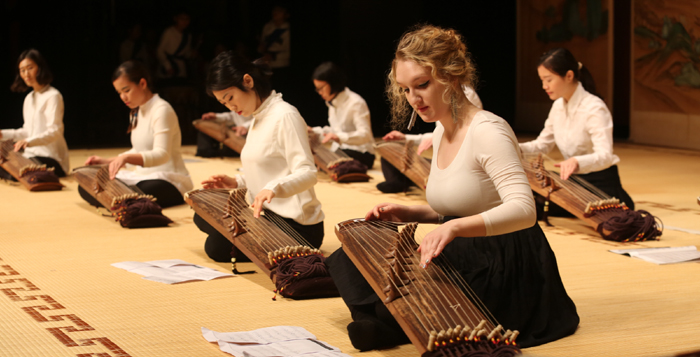Physical Address
304 North Cardinal St.
Dorchester Center, MA 02124
Physical Address
304 North Cardinal St.
Dorchester Center, MA 02124

Are you interested in exploring the rich cultural heritage of Korea? One fascinating aspect of Korean culture is its traditional music, known as Gugak. This genre has a long history dating back to ancient times and has evolved over the centuries to become an integral part of Korean identity.
Gugak encompasses a wide variety of musical styles and instruments, each with its unique characteristics and significance. From solemn court music to lively folk tunes, Gugak reflects the diverse experiences and emotions of the Korean people throughout history.
Whether you are a music enthusiast or simply curious about other cultures, learning about Gugak can provide insight into the traditions and values that have shaped Korea’s vibrant society.

You’ll be fascinated by the history of Gugak, a genre of Korean traditional music that has been passed down for centuries. The origins of Gugak can be traced back to ancient times, with references found in historical documents dating back to the 12th century. Throughout its long history, Gugak has undergone many evolutionary changes, reflecting the social and cultural transformations that have taken place in Korea.
Gugak’s roots are deeply entwined with Korea’s historical and cultural narrative, stretching back through the eras of Korean dynasties. The Joseon Dynasty, in particular, played a pivotal role in the institutionalization of Gugak, using it extensively in state rituals and royal ceremonies. This period saw the formalization of many musical forms and the establishment of the Aak, a genre of court music inspired by Chinese ceremonial music, illustrating the cross-cultural exchanges that have influenced Gugak. These interactions enriched the Korean musical landscape, integrating diverse elements while nurturing distinct local traditions.
Over time, regional variations emerged as different areas developed their own unique styles and techniques. These regional variations are still evident today and contribute to the diversity of the genre. For example, the court music of Seoul is known for its refined elegance while the music from Jeju Island is characterized by its lively rhythms.
For instance, Namdo Minyo, originating from the Jeolla province, is celebrated for its expressive melodies and storytelling, often depicting the lives and aspirations of ordinary people. In contrast, Gyeonggi Minyo, from the Gyeonggi region, features more structured rhythms and themes, reflecting the influence of the capital’s sophisticated culture. These regional differences are not just about sound; they also encapsulate the lifestyle, environment, and societal structures of their places of origin, offering insight into Korea’s rich tapestry.
Despite being an ancient musical tradition, Gugak continues to evolve to this day. Modern composers are incorporating new instruments and experimenting with new sounds while still maintaining respect for traditional forms. This balance between tradition and innovation ensures that Gugak remains relevant and meaningful in contemporary society.
As you learn about the fascinating history of Gugak and its regional variations, you’ll discover that it encompasses a wide range of genres including instrumental music, vocal music, dance music, ceremonial music, and more. Each genre has its own distinct characteristics and plays an important role in Korean culture.
Now, let’s dive deeper into the different genres of Gugak. You’ll learn about Court Music, which was traditionally played at royal ceremonies and banquets. Folk Music, on the other hand, originated from the common people and includes regional variations like Pansori and Minyo. Lastly, Religious Music has a strong connection to Buddhism and Shamanism, with instruments like the Gayageum being used in ritualistic contexts. Together, these genres make up the rich tapestry of traditional Korean music.

If you’re interested in Court Music, you’ll be delighted to know that it has a rich history dating back to the Three Kingdoms period. This genre of gugak was once exclusively performed at the royal court as ceremonial music for kings and aristocrats. Here are three things you might find interesting about Court Music:
Moving on from Court Music, let’s take a look at another type of gugak: folk music.
Immerse yourself in the lively beats and colorful melodies of Korea’s vibrant folk scene. With regional variations that span across the country, Korean folk music or minyo, is a celebration of the rich cultural heritage that has been passed down through generations. The music showcases a wide range of instruments such as the gayageum (12-stringed zither), haegeum (two-stringed fiddle) and piri (bamboo oboe) among others, which add to its distinctiveness.
Modern adaptations have brought this traditional art form to popular culture where it continues to thrive. From reinterpretations by contemporary bands to collaborations with international artists, Korean folk music has evolved in ways that reflect modern sensibilities while staying true to its roots. Whether it’s the captivating sounds of Arirang or the energetic rhythms of Jindo Bukchum, there’s something for everyone in this genre.
As we move on to religious music, it’s important to note how deeply ingrained these traditions are within Korean culture and how they continue to shape contemporary art forms.
Explore the fascinating world of religious music in Korea, where you can discover how spirituality and art intertwine to create a unique sound that touches the soul. Korean religious traditions have played a significant role in shaping the country’s musical heritage, with religious music often used as a form of worship or communication with the divine. From Buddhist chants to shamanic rituals, there is a diverse range of religious music styles that reflect different beliefs and practices.
To give you an idea of what makes Korean religious music so special, here are some key characteristics:
As you move on to learn about the instruments used in gugak, keep in mind how these traditional sounds were shaped by spiritual practices throughout history.
You’ll love the rich sounds of the various instruments used in Gugak, from the gentle plucking of the gayageum to the powerful beats of the janggu drum. Traditional vs modern instruments play a significant role in Gugak music. Traditional instruments are those that have been used for centuries and have unique cultural significance, while modern instruments are more recent additions that aim to expand Gugak’s reach to younger audiences.
Influence on popular music is also evident as many K-pop artists incorporate traditional Korean instruments into their songs. The most popularly known instrument being used is the gayageum and its sound can be heard in some of BTS’ songs like “Spring Day”and “Blood Sweat & Tears.”Other traditional Korean instruments such as daegeum, haegeum, and piri can also be heard in K-pop music.
Modern technology has also left its mark on Gugak, with electronic enhancements creating new soundscapes. Some contemporary artists incorporate samplers and synthesizers alongside traditional instruments, producing music that resonates with younger audiences while respecting traditional roots. This innovative approach is exemplified by pieces that use the geomungo in electronic dance music, drawing parallels between intricate rhythms of past and the beats of today. Such evolutions ensure that Gugak continues to inspire and challenge both listeners and musicians, bridging the past and future in a harmonious dialogue.
The following table describes some of the most commonly used instruments in Gugak:
| Instrument | Description |
|---|---|
| Gayageum | A zither-like string instrument with 12 silk strings plucked with a bamboo stick called suldae. It has a bright tone and is often played solo or as an accompaniment to vocal performances. |
| Daegeum | A large bamboo flute with six finger holes and one thumb hole. It produces deep, breathy tones that mimic human emotions and can be played solo or as part of an ensemble. It is often associated with Buddhist ceremonies and shamanistic rituals. |
| Janggu | A double-headed hourglass-shaped drum made from animal hide stretched over wooden frames. It produces a deep bass sound when struck with one hand while playing high-pitched tones with the other hand holding a stick. It is often used in traditional dance performances and as an accompaniment to vocal music. |
The use of various instruments in Gugak showcases Korea’s rich cultural history and traditions. These instruments have been passed down for generations and continue to play an important role in Korean music today, both traditional and modern. The importance of Gugak in Korean culture extends beyond just entertainment; it serves as a reminder of the country’s past and preserves its cultural identity.

You might be wondering why Gugak is important in Korean culture. Firstly, it’s a significant part of Korea’s cultural heritage, representing the country’s history and traditions through its music and dance. Secondly, Gugak serves as entertainment for people of all ages, whether it’s enjoying a live performance or listening to recordings at home. Lastly, Gugak is also an essential aspect of education in Korea, teaching younger generations about their cultural roots and fostering a deeper appreciation for their country’s artistic legacy.
Korean traditional music, or gugak, holds a special place in the country’s cultural heritage. Not only does it serve as a source of entertainment, but it also plays an important role in preserving Korea’s cultural identity. In fact, gugak is recognized by UNESCO as an intangible cultural heritage of humanity.
The recognition from UNESCO highlights the value and importance of gugak in Korean culture. It acknowledges that this traditional art form has been passed down through generations and serves as a symbol of the country’s rich history and traditions. Gugak reflects the values, beliefs, and customs that have shaped Korean society for centuries. Through its preservation and promotion, gugak continues to contribute to the development of Korean culture today.
As we move into discussing entertainment in relation to gugak, it is important to recognize how this traditional music goes beyond just being a form of amusement.
Get ready to be transported to a world of mesmerizing sounds and captivating performances with gugak, the traditional music of Korea. With its unique instruments and distinct style, gugak has been entertaining audiences for centuries. But what makes it even more fascinating is how it has evolved over time.
Today, Korean traditional music is not just limited to ancient practices but has also fused with modern influences. This fusion has brought about a new wave of gugak that appeals to global audiences. From jazz-inspired improvisations to contemporary adaptations, gugak continues to captivate listeners worldwide. Its popularity can be seen in the increasing number of concerts and festivals dedicated solely to traditional Korean music. So sit back and let yourself be transported by the enchanting melodies of gugak.
As you delve deeper into the world of gugak, you’ll discover that education plays a crucial role in preserving this rich cultural heritage.
Let’s explore how education plays a vital role in preserving the rich cultural heritage of gugak. In South Korea, schools have been instrumental in ensuring that traditional Korean music continues to thrive. The government has made efforts to integrate gugak into the school curriculum, allowing students to learn about and appreciate this art form from a young age.
The table below highlights the different ways in which gugak is taught in schools and the challenges faced by educators:
| Role in Schools | Challenges Faced |
|---|---|
| Gugak classes are offered as part of the regular curriculum at some schools. | Lack of funding for equipment such as traditional instruments. |
| Some schools have dedicated gugak clubs where students can learn more about this art form. | Limited resources for teacher training and development. |
| Gugak competitions are held annually, providing a platform for students to showcase their skills. | Difficulty attracting younger generations who may prefer Western music styles. |
Despite these challenges, many educators remain passionate about preserving gugak and passing it on to future generations. Through education, we can ensure that this mesmerizing art form continues to thrive and gain recognition both nationally and internationally.
Moving into the subsequent section about UNESCO recognition, it’s important to note that while education plays a crucial role in preserving gugak, international recognition is also essential for its continued growth and popularity.
Now let’s talk about the UNESCO recognition of Gugak. Did you know that in 1964, Gugak was designated as an Intangible Cultural Asset by the South Korean government? This recognition highlights the importance of preserving and promoting this traditional music genre. In recent years, efforts have been made to preserve Gugak through initiatives such as education programs and festivals.
You may not realize it, but the intangible cultural assets of Korean traditional music are just as valuable and important as physical artifacts. These intangible assets refer to skills, knowledge, techniques, and practices that have been passed down from generation to generation within a community. They hold cultural significance and are an essential part of artistic expression in Korea.
Here are three examples of intangible cultural assets that make up Korean traditional music: 1) Pansori singing is a vocal art form that tells epic stories through song. It requires extensive training to master the unique vocal techniques and emotional delivery required for each story. 2) Traditional dance forms, such as Salpuri or Seungmu, involve intricate movements that convey specific emotions and meanings. They require years of practice to perfect the fluidity, precision, and gracefulness required for each piece. 3) Instrumental music played on traditional instruments like Gayageum or Haegeum requires skillful technique and a deep understanding of how to create different tones, rhythms, and melodies using these ancient instruments.
Korean traditional music’s intangible cultural assets are treasured by many Koreans who recognize their value in preserving their heritage. Preservation efforts aim at safeguarding these traditions while also ensuring they remain relevant in contemporary society.
Immerse yourself in the rich history and culture of Korea as efforts to preserve its unique intangible cultural assets are underway. One of these efforts is on the revitalization of gugak, or Korean traditional music. The government has established various institutions, organizations, and festivals to promote and preserve gugak not just within Korea but also abroad. In fact, there are now international gugak competitions that showcase the talent and beauty of this traditional art form.
To give you a glimpse into these preservation efforts, here’s a table showing some notable institutions that promote gugak:
| Institution | Purpose | Notable Programs |
|---|---|---|
| National Gugak Center | Preserve and develop gugak through research, education, performance, etc. | Annual Jeongdong Theater Tradition Series |
| Korean Traditional Performing Arts Foundation (KTPAF) | Promote international recognition of Korean traditional performing arts including gugak | Overseas performances in countries such as China and France |
| Gyeonggi Arts Center for Youth & Children (GACYC) | Introduce children to Korean traditional performing arts including gugak through education programs and performances | Annual “Gukgeuk-Talchum”Festival |
As you can see from the table above, there are various ways in which Korea is trying to keep its traditions alive through different institutions and programs. These efforts have led to a renewed interest in gugak both within Korea and outside its borders. Now let’s take a look at some notable performers who have helped popularize this beautiful art form even further.
When it comes to notable Gugak performers, you’ll find a rich history of historical figures who have contributed immensely to the development of Korean traditional music. These include King Sejong and Yi Saenggang, both renowned for their musical prowess. In contemporary times, there are also many talented artists who continue to promote and advance Gugak on the global stage.
Get to know some of the key historical figures who have contributed to the development and preservation of gugak, such as Yi Saenggang and Hwang Byungki. Yi Saenggang was a prominent musician during the Joseon Dynasty (1392-1910) who composed many pieces that are still performed today. His influence on modern music is evident in his use of traditional instruments like the gayageum and his incorporation of various regional styles into his compositions.
Hwang Byungki, on the other hand, is a more contemporary figure who has played a significant role in preserving gugak while also pushing it forward. He is known for incorporating Western elements into his music while still maintaining its traditional essence. His impact on society stretches beyond just music, as he has also worked to promote cultural understanding through education and performances both within Korea and abroad. With these important historical figures paving the way for gugak’s continued evolution, let’s now turn our attention to some of the contemporary artists keeping this tradition alive today.
You’ll be blown away by the creativity and passion of today’s gugak artists, who are pushing the boundaries and creating new sounds that honor the rich history of this art form. One notable trend is collaborations with Western musicians, which have resulted in mesmerizing performances that blend traditional Korean instruments with contemporary styles like jazz and electronic music. For example, the band Black String has gained international recognition for their unique fusion sound, which incorporates elements of traditional Korean music with improvisation and experimentation.
In addition to collaborations with Western musicians, gugak artists are also exploring fusion with other music genres from around the world. This has led to exciting cross-cultural exchanges that showcase the versatility and adaptability of gugak. The group Sookmyung Gayageum Orchestra is one such example, as they infuse classical Korean music with Latin rhythms and flamenco guitar to create a vibrant and dynamic performance experience. These innovative approaches to gugak demonstrate how it continues to evolve while preserving its cultural heritage.
Transitioning into the subsequent section about ‘gugak festivals and events’, it’s worth noting that many of these contemporary artists can be seen performing at various celebrations throughout Korea.

Gugak festivals and events are the perfect places to immerse yourself in the lively and colorful world of traditional Korean music. These events, held throughout the year in various cities across Korea, offer a unique opportunity to experience gugak fusion, modern interpretations of traditional tunes by contemporary artists.
One such festival is the Seoul Traditional Music Festival, which features both indoor and outdoor performances by some of Korea’s most talented gugak musicians. The festival also offers workshops and classes where visitors can learn more about Korean traditional instruments such as the gayageum and janggu.
Another popular event is the Andong Mask Dance Festival, which celebrates both mask dance traditions and gugak music from around Korea. Visitors can watch performances by masked dancers while listening to live gugak music played on traditional instruments.
If you’re interested in experiencing a more intimate setting, there are also smaller events like the Gyeongju World Culture Expo or local town festivals that often feature performances by local musicians. These events provide a chance to get up close with performers and learn about their personal connection to gugak.
Attending these festivals and events not only allows you to appreciate the beauty of traditional Korean music but also helps preserve this important cultural heritage for future generations. Now that you’ve learned about some of these exciting opportunities for experiencing gugak first-hand, it’s time to take your interest in Korean culture further by learning how to play one of these beautiful instruments yourself!
Learning to play a gayageum or janggu can be a fun and rewarding way to immerse yourself in the rich culture of Korea. Whether you are interested in traditional music or simply looking for a new hobby, gugak offers a unique opportunity to explore Korean history and customs. Fortunately, there are many online resources available that can help you get started.
One great way to learn gugak is through cultural immersion programs. These programs provide an opportunity to study with experienced musicians, attend performances, and participate in traditional activities like tea ceremonies and calligraphy classes. By immersing yourself in Korean culture, you can gain a deeper understanding of the music and its significance.
Another option for learning gugak is through online resources such as YouTube tutorials or instructional websites. While these may not offer the same level of cultural immersion as a formal program, they can still be an effective way to learn basic techniques and familiarize yourself with different instruments. Additionally, many museums and cultural centers offer virtual tours that allow you to explore exhibits related to gugak from the comfort of your own home.
No matter how you choose to learn gugak, it’s important to approach it with an open mind and willingness to embrace new experiences. As with any musical genre, mastering traditional Korean music takes practice and dedication – but the rewards are well worth it. By exploring this rich tradition, you can gain insight into one of the world’s oldest cultures while enjoying beautiful melodies and intricate rhythms that have been passed down for generations.
| Emotion | Description | Example |
|---|---|---|
| Joyful | Learning gugak is an exciting experience filled with vibrant sounds and colorful traditions. | Imagine hearing the upbeat tempo of janggu drums during a dance performance at a festival! |
| Reflective | Gugak provides an opportunity for self-reflection as performers often express deep emotions through their music. | Listening attentively to a solo performance on the gayageum can be a meditative experience. |
| Culturally-enriching | Gugak is deeply rooted in Korean history and culture, offering a fascinating window into the country’s past. | By learning gugak, you can gain insights into traditional Korean values like respect for elders and harmony with nature. |
Overall, you have gained a great introduction to Gugak, the traditional music of Korea. You now understand its rich history, diverse genres, and unique instruments. It is clear that Gugak holds significant importance in Korean culture and has even been recognized by UNESCO as an intangible cultural heritage.
If you are interested in exploring more about this musical tradition, there are plenty of opportunities to do so through festivals and events or even by learning how to play one of the many instruments used in Gugak. By delving further into the world of Gugak, you can gain a deeper appreciation for Korean culture and its rich artistic heritage.